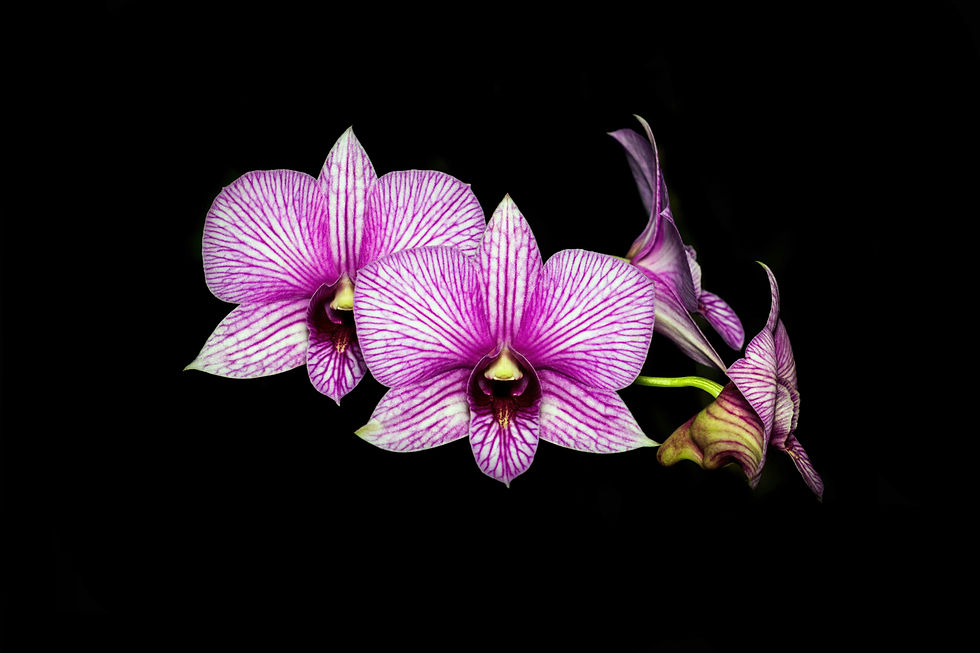All About Growing and Caring for Dendrobium Orchids
- Guna Orchids

- Apr 14
- 4 min read
Dendrobium orchids are known for their stunning blooms and unique growth habits. These tropical beauties come in various species and hybrids, fascinating many plant enthusiasts. Growing and caring for these orchids can be a rewarding hobby when you have the right knowledge and tools.
Understanding Dendrobium Orchids
Dendrobium orchids belong to a large genus of orchids, boasting over 1,800 species. They are native to Asia and the Pacific Islands and thrive in warm climates. The flowers can appear in many colors, shapes, and sizes, making them appealing to a wide audience. Most Dendrobium species grow on trees or rocks and prefer bright, indirect sunlight.

Characteristics of Dendrobium Orchids
Dendrobium orchids typically have elongated canes, with thin leaves that grow vertically. They are known for their epiphytic nature, which means they can grow on other plants while deriving moisture and nutrients from the air and rain. Many Dendrobium species thrive in humid conditions and enjoy a well-ventilated environment. Their adaptability makes them suitable for both beginners and experienced orchid growers.
The Ideal Environment for Dendrobium Orchids
Creating the perfect environment for your Dendrobium orchids is crucial for their growth. Here are some essential factors to consider:
Light Requirements
Dendrobium orchids prefer bright, indirect sunlight. A south or east-facing window is suitable for these beauties. If you notice that the leaves are turning yellow, it might be a sign that they are receiving too much light. Conversely, if the plant is not blooming, it may need more light.
Temperature and Humidity
These orchids thrive in temperatures between 60°F and 80°F (15°C to 27°C). They enjoy high humidity levels, ideally around 50% to 70%. Using a humidifier or pebble tray filled with water can help maintain moisture in the air, especially during dry seasons.
Potting and Soil
Dendrobium orchids require a well-draining potting medium. A mix of bark, sphagnum moss, and perlite works well. You can also use commercially available orchid potting mixes. It's crucial to choose a pot with drainage holes to prevent root rot.

Can Dendrobium Grow in India?
Yes, Dendrobium orchids can grow in India, especially in the warmer regions where temperatures and humidity levels are conducive to their growth. The Indian climate, with its diverse ecosystems, offers suitable conditions for many Dendrobium species. However, it is essential to understand the local climate in your area, as some species may thrive better than others.
In regions with cooler temperatures, it’s advisable to grow the orchids indoors or in controlled environments. They need protection from harsh weather elements, especially during the winter. Proper care can result in beautiful blooms throughout the year.
Watering Your Dendrobium Orchids
Watering is a vital aspect of caring for these orchids. Unlike many other plants, it's crucial to let the potting medium dry out slightly between watering. Here's how to get it right:
Frequency: Generally, water every 1-2 weeks depending on humidity and temperature.
Indicators: Check the mix for dryness. If the bark is dry to the touch, it's time to water.
Method: Water thoroughly so that water drains out of the bottom of the pot. Avoid letting the plant sit in water.
Fertilizing Dendrobium Orchids
Fertilizing is essential to encourage blooming and healthy growth. Here are some tips on how to fertilize your Dendrobium orchids:
When to Fertilize
During the growing season (spring and summer), you should fertilize every two weeks using a balanced orchid fertilizer (20-20-20). In fall and winter, reduce the frequency to once a month.
How to Fertilize
Dilution: Always dilute your fertilizer to half the recommended strength to avoid burning the roots.
Application: Apply the fertilizer during the watering process. Ensure to water beforehand to provide moisture to the roots.
Common Pests and Problems
Despite their robust nature, Dendrobium orchids can face some challenges. Here are common pests and how to identify and address them:
Common Pests
Mealybugs: These tiny, white cotton-like pests can be found on the plant's leaves and stems. Use insecticidal soap or neem oil to treat infestations.
Scale: Brown, raised bumps on leaves indicate a scale infestation. Remove them manually and follow up with an insecticidal treatment.
Fungal and Bacterial Infections
Watch for signs of yellowing leaves or black spots, which may indicate fungal issues. Ensure proper air circulation and avoid overwatering to minimize these risks. If infections occur, adjust your watering habits and apply appropriate fungicides as needed.

Encouraging Blooms in Dendrobium Orchids
To enjoy the stunning flowers of your Dendrobium orchids, it's essential to encourage blooming. Here are actionable steps to promote flowering:
Light Exposure
Ensure your orchids receive sufficient light, as inadequate light can result in fewer blooms. Adjust their placement seasonally to maximize sunlight exposure.
Temperature Control
Many Dendrobium species require a temperature drop at night to stimulate blooming. Ensure you provide a cooler environment at night, mimicking their natural habitat.
Dormancy Period
Allow the orchids to experience a slight dormancy period in the fall and winter with reduced watering and feeding. This cycle is crucial for promoting prolific blooming in the spring.
Encouraging the growth and thriving condition of your Dendrobium orchids is a journey that requires patience and attention to detail. With the right care, these remarkable plants can bring beauty and joy to any space. Happy growing!



Comments